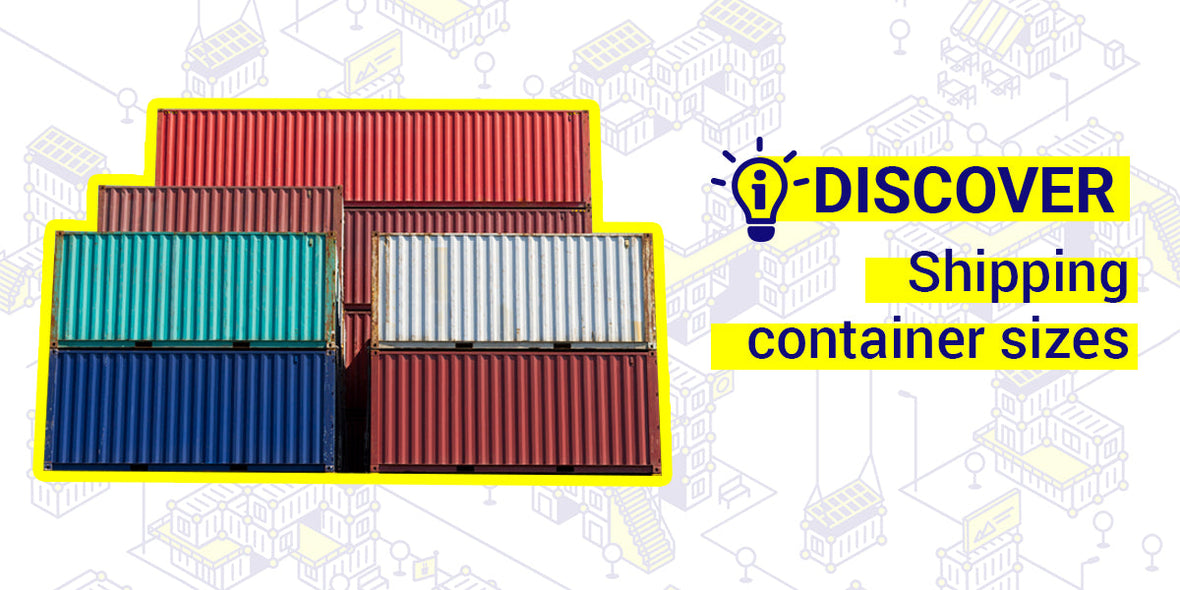
The guide to shipping container sizes & dimensions
Shipping containers are built to internationally recognised standards set by the International Standards Organisation (ISO) which means that they need to adhere to specific size requirements. This guide covers essential information about standard dimensions, special container sizes and types, and optimal sizes for conversions.
This article provides helpful insights, including:
- Standard shipping container sizes and dimensions
- Larger sizes (high cube) and their dimensions
- Smaller container sizes and custom sizes
- Popular container sizes for conversions
- Frequently asked questions
What dimensions are standard size shipping containers?
All standard ISO shipping containers are 8ft (2.44m) wide to ensure that they can be fastened together and stacked on top of each other on board a cargo vessel. Standard ISO shipping containers are 8.5ft (2.59m) high and come in four lengths; 10ft, 20ft 40ft and 45ft externally. (The same applies to Conex box sizes and dimensions.)
Extra tall, or ‘high cube’ containers as they are known (sometimes shortened to HC), come in at 9.5ft (2.89m) high to provide additional volume but the rest of the dimensions are the same.
💡All ISO shipping containers feature standardised corner castings - strong metal fittings on each corner that allow containers to be lifted, secured, and stacked safely. These corner castings can be transformed into practical attachment points with Domino Clamps, specialised connectors that enable you to attach structures, equipment, or modifications for container conversion projects or any other attachments needed on containers.
1. Standard ISO Shipping Container Sizes
All standard containers are 8 feet wide and 8.5 feet high, which ensures compatibility for stacking and securing during transport.
Standard Container Size & Dimensions Table (Imperial/US customary system)
|
Dimensions |
10ft Standard |
20ft Standard |
40ft Standard |
45ft Standard |
|
Exterior Dimensions |
9'9.75" x 8' x 8'6" |
19'10.5" x 8' x 8'6" |
40' x 8' x 8'6" |
45' x 8' x 8'6" |
|
Interior Dimensions |
9'3" x 7'8" x 7'10" |
19'3" x 7'8" x 7'10" |
39'5" x 7'8" x 7'10" |
44'5" x 7'8" x 7'10" |
|
Volume |
560 cubic feet |
1,170 cubic feet |
2,385 cubic feet |
2,700 cubic feet |
|
Door Opening |
7'8" x 7'5" |
7'8" x 7'5" |
7'8" x 7'5" |
7'8" x 7'5" |
|
Square Footage |
75 sq ft |
150 sq ft |
300 sq ft |
330 sq ft |
|
Typical Weight |
2,850 lb |
5,050 lb |
8,000 lb |
8,600 lb |
All dimensions and weights are approximate as containers vary from manufacturer to manufacturer.
Standard Container Size & Dimensions Table (Metric System)
|
Dimensions |
10ft Standard |
20ft Standard |
40ft Standard |
45ft Standard |
|
Exterior Dimensions |
2.99 m x 2.44 m x 2.59 m |
6.06 m x 2.44 m x 2.59 m |
12.19 m x 2.44 m x 2.59 m |
13.72 m x 2.44 m x 2.59 m |
|
Interior Dimensions (L x W x H) |
2.82 m x 2.34 m x 2.39 m |
5.90 m x 2.34 m x 2.39 m |
12.03 m x 2.34 m x 2.39 m |
13.50 m x 2.34 m x 2.39 m |
|
Door Opening |
2.34 m x 2.26 m |
2.34 m x 2.26 m |
2.34 m x 2.26 m |
2.34 m x 2.26 m |
|
Square Footage |
6.97 m² |
13.93 m² |
27.87 m² |
31.40 m² |
|
Volume |
15.9 m³ |
33.2 m³ |
67.7 m³ |
76.4 m³ |
|
Typical Weight (Empty) |
1,296 kg |
2,177 kg |
3,810 kg |
4,800 kg |
All dimensions and weights are approximate as containers vary from manufacturer to manufacturer.
2. High Cube ISO Shipping Container Sizes
High cube containers are designed with an additional 1ft (30.5 cm) of height, making them 9.5ft (2.89 metres) tall.
High cube containers offer approximately 12% more volume than their counterparts with standard height, and provide extra space for bulky cargo or larger items. They're also popular for container home conversions or shipping container offices. The extra height helps create a more spacious and comfortable living environment.
High Cube Container Size Table (Imperial/US customary)
|
Dimensions |
20ft |
40ftt |
45ft |
|
External Dimensions |
20' 0" x 8' 0" x 9' 6" |
40' 0" x 8' 0" x 9' 6" |
45' 0" x 8' 0" x 9' 6" |
|
Internal Dimensions |
19' 4" x 7' 9" x 8' 10" |
39' 5" x 7' 8" x 8' 10" |
44' 5" x 7' 8" x 8' 10" |
|
Door Opening |
7' 8" x 8' 5" |
7' 8" x 8' 5" |
7' 8" x 8' 5" |
|
Volume |
1,320 cu ft |
2,669 cu ft |
3,040 cu ft |
|
Typical Weight |
4,820 lbs |
8,500 lbs |
10,500 lbs |
All dimensions and weights are approximate as containers vary from manufacturer to manufacturer.
High Cube Container Size Table (Metric)
|
Dimensions |
20ft |
40ft |
45ft |
|
Exterior Dimensions |
6.06 m x 2.44 m x 2.89 m |
12.19 m x 2.44 m x 2.89 m |
13.72 m x 2.44 m x 2.89 m |
|
Interior Dimensions |
5.90 m x 2.35 m x 2.69 m |
12.00 m x 2.35 m x 2.69 m |
13.50 m x 2.35 m x 2.69 m |
|
Door Opening |
2.34 m x 2.58 m |
2.34 m x 2.58 m |
2.34 m x 2.58 m |
|
Square Footage |
13.9 m² |
28.2 m² |
31.7 m² |
|
Volume |
37.4 m³ |
76.3 m³ |
76.4 m³ |
|
Typical Weight |
2,260 kg |
3,800 kg |
4,500 kg |
All dimensions and weights are approximate as containers vary from manufacturer to manufacturer.
3. Smaller sizes and custom container sizes
While standard container sizes like 10ft, 20ft, and 40ft are the most common, there are several smaller and custom options available. Here are some details on these alternatives and their use:
-
Less common than the standard 10, 20, and 40ft options are 8ft and 12ft ISO-containers. These are primarily designed for storage or temporary structures, and are generally not shipped across the ocean.
-
Some companies offer cut-down versions of 20ft and 40ft containers so that customers can choose a size they need, this is a good solution if you need something bigger than a 20ft container for a conversion project, but don’t have the room for a 40ft container for example.
- Additionally, it is possible to cut two containers and combine them. This also makes it possible to create any wished length or configurations. This method is particularly useful for creating bigger modular offices, container houses, shops, or event areas. (When modifying containers, it is always important to maintain their structural integrity, and consider consulting conversion specialists.)
4. What is the best size for shipping container conversions?
To find the best container size for a conversion project it is not just important to consider individual needs and preferences, but also the space available, the budget and transportation.
A 20ft container is ideal for projects like tiny homes or garden houses, while for example a 45ft high cube offers more space for large offices or bigger container homes. When selecting a container, consider site access and budget for the container itself, modifications, and transportation. Smaller containers are easier to transport and fit into tighter spaces, whereas larger ones can lead to higher transportation and installation costs.
Popular shipping container uses by size for container conversions
- 10-Foot Containers (72 sq ft / 6.7 m²)
10ft containers are often used for parking booths, small site offices, kiosks, retail storage, and small site offices. They are light and easy to move, especially ideal for temporary setups.
Commonly used for storage solutions, such as self storage sites, on construction sites, sports clubs, or as sheds. They are also suitable for small conversions like home gyms, tiny houses, container offices, or food stands.
- 40-Foot Containers (300 sq ft / 27.9 m²)
This is a popular size for shipping container homes and larger commercial projects like retail units, shipping container bars, or offices.
- 40-Foot High Cube Containers (304 sq ft / 28.3 m²)
Often used for container homes or businesses. The extra headroom is beneficial for creating loft areas or homes and offices with a spacious architecture.
5. FAQ - Container Size & Dimensions
What are the standard sizes for shipping containers?
Standard shipping container sizes are 10-foot, 20-foot, 40-foot, and 45-foot containers. The recognised standards set by the International Standards organisation (ISO) ensure that all of these containers meet specific size requirements.
How big is a 20-foot shipping container?
A 20-foot shipping container typically measures 20 feet (6.06 metres) in length, 8 feet (2.44 metres) in width, and 8.5 feet (2.59 metres) in height. Internally, it measures approximately 19.3 feet (5.88 metres) in length, 7.9 feet (2.39 metres) in width, and 7.9 feet (2.39 metres) in height.
How big is a 40-foot shipping container?
A 40-foot shipping container usually measures 40 feet (12.19 metres) in length, 8 feet (2.44 metres) in width, and 8.5 feet (2.59 metres in height. Internally, it offers approximately 39.5 feet (12.04 metres) in length, 7.9 feet (2.39 metres) in width, and 7.9 feet (2.39 metres) in height.
Are all shipping containers 8 feet wide?
Yes, all standard shipping containers are 8 feet wide to make sure they are compatible for stacking and securing during transport on cargo ships, trains and trucks.
What are specialised shipping containers?
Besides standard and high cube containers, there are specialised container types for unique needs:
- Refrigerated Containers (Reefers): Keep temperatures regulated for perishable items like food and pharmaceuticals.
- Open Top Containers: Allow loading from above for tall or irregularly shaped cargo.
- Flat Rack Containers: Feature collapsible sides for transporting heavy machinery or vehicles.
- Tank Containers: Used for transporting liquids such as chemicals or oils, meeting international safety standards.
Further Reads & Links:
-
Check out our other blog articles for useful information on how to convert your container or attach almost anything to it.
- Visit our YouTube channel for product videos and step-by-step tutorials to help you customise and get the most out of your container—without welding or drilling!






